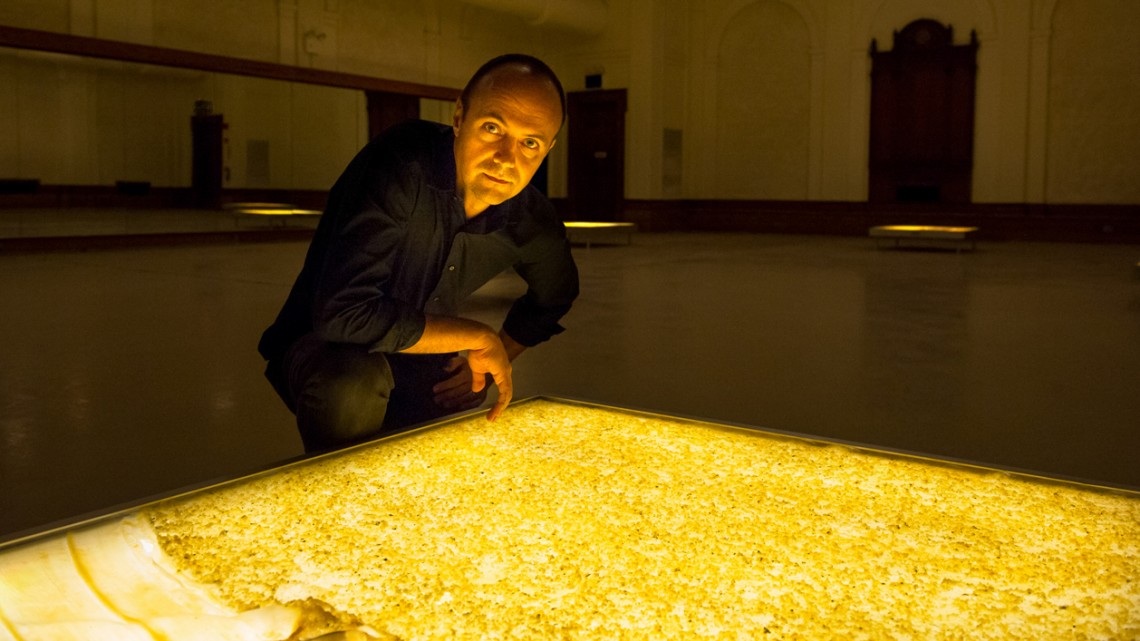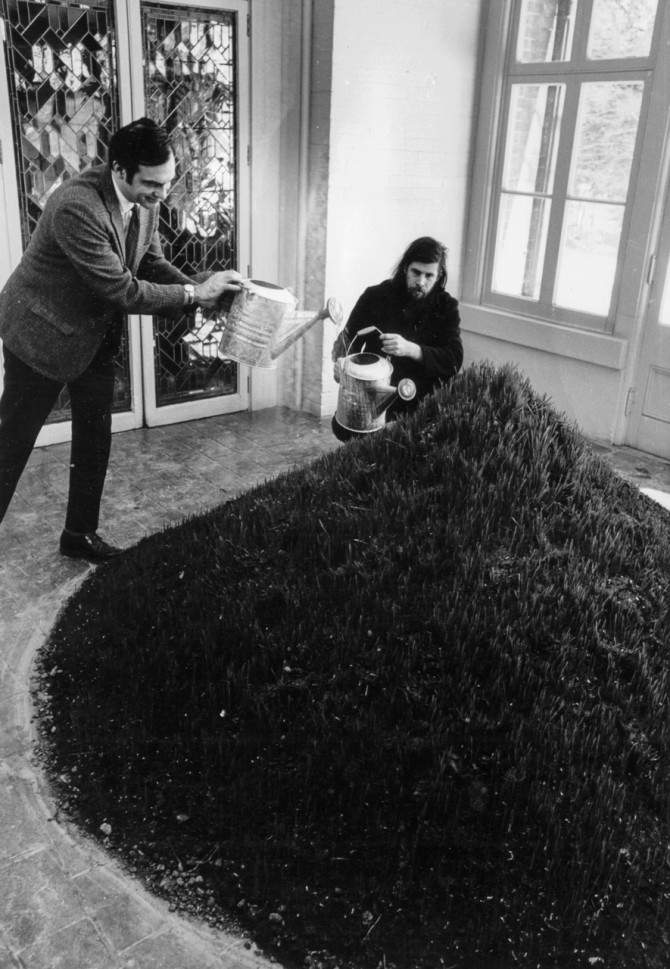
Artist and designer Jorge Otero-Pailos, B.Arch. ’94, M.Arch. ’95, with work from an “Ethics of Dust” project, preserving material removed from historic monuments.
Symposium to mark 50th anniversary of ‘Earth Art’
By Daniel Aloi
Designers and scholars will reflect on the legacy of the landmark 1969 Earth Art exhibition at Cornell in “Earth: Projections 50 Years After ‘Earth Art,’” Nov. 7-8 in Milstein Auditorium.
Presented by the Department of Architecture, the Preston H. Thomas Memorial Lecture Series symposium will mark the 50th anniversary of the exhibition of in situ works at the Andrew Dickson White Museum of Art, now the A.D. White House. Symposium events are free and open to the public.
Participants will discuss the original event’s significance for art, architecture and design in the contemporary context, defined by planetary environmental crises. The symposium will encompass perspectives of sustainability, climate change, land art, architectural history and historic preservation, anthropology and philosophy.
Curated in 1969 by museum director Thomas Leavitt, professor of the history of art, and guest curator Willoughby Sharp, “Earth Art” featured land and environmental art by Jan Dibbets, Hans Haacke, Michael Heizer, Neil Jenney, Richard Long, David Medalla, Robert Morris, Dennis Oppenheim, Robert Smithson and Günther Uecker. The exhibition, the first of its kind in America, was a profound provocation for an ethical and political reorientation toward Earth, according to symposium organizers.
The symposium will feature four lectures from design practitioners and prominent scholars in art, architectural history and philosophy, each approaching the legacy of the “Earth Art” exhibition from different but related perspectives.
The scholars are Peg Rawes, professor of architecture and philosophy at the Bartlett School of Architecture at University College, London; and James Nisbet, associate professor of art history and visual studies at the University of California, Irvine.
The designers – Rania Ghosn, of Design Earth and associate professor of architecture and urbanism at the Massachusetts Institute of Technology, and Jorge Otero-Pailos, B.Arch. ’94, M.Arch. ’95, of Otero-Pailos Studio and professor and director of historic preservation at Columbia University – will also exhibit work specifically commissioned for the symposium.
Ghosn’s entry, “Flag the Earth,” stages the Climate Emergency flag that was raised on the roof of Rand Hall during the Global Climate Strike on Sept. 20.
“This installation is an ethical plea to keep fossil fuels in the ground and for cultural institutions to act now in responding to the climate crisis,” Ghosn said in an artist statement.
“The flag appropriates Flag of the Earth to visualize the planet’s carbon budget in a series of three concentric circles. The thickness of each is proportional to CO2 emissions – CO2 already released into the atmosphere from burning fossil fuels between 1850 and 2018; the allowance before the 2 degrees Centigrade benchmark; and the ‘business as usual’ scenario should fossil fuel corporations burn all that they currently hold in their reserves,” she said.
Otero-Pailos’ installation, “Far Above,” relates to the iconic view associated with Cornell, from the Johnson Museum down to Cayuga Lake.
“When we just look at the lake, we don’t see the air. We see the lake, and we forget the air,” he said. “I became obsessed with this notion of haze in the air; that these dust particles in the air can actually affect our visibility and the way that we perceive the world.”
The view also includes a coal-fired power plant, “one of the biggest polluters,” Otero-Pailos said.
“They used to emit fly ash and then sulfur dioxide, which reacts with the limestone [in the smokestack] and makes gypsum,” he said. “They sell that gypsum to make drywall, so we are in a way surrounded by the byproduct of this process of using stones to clean the sky.”
The installation, on display Nov. 5-9 in Milstein Hall, represents this relationship between the earth and the sky, he said. It incorporates local limestone and features six films of the sky above the sightline of the view, projected onto painted gypsum panels.
The panels frame a telescoping view to Cayuga Lake, and are painted with ink Otero-Pailos made from dust he collected from the windows of houses facing the lake.
“I thought it was important to see the actual medium of the view,” he said. “In these videos, the sky is just totally active. There’s clouds moving left and right, there’s birds and airplanes, you can sense the wind, you can sense the density of the sky.”
Media Contact
Get Cornell news delivered right to your inbox.
Subscribe

